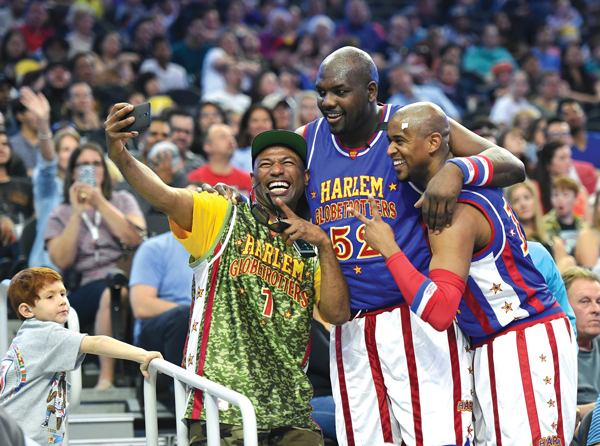D uring a recent snowstorm, my family and I were stranded in multiple airports across the country. As we jumped from terminal to terminal, we were inundated with ads for sports and entertainment events taking place in each particular city. The ads were predictably tactical — date, time and place — and the only events that got my sons, age 20 and 16, to look up from their phones were those that were already part of their social universe. The ones that were myopically selling just the live event on its own had no appeal and no chance of gaining our business.
Witnessing this reinforced the notion that live events cannot attract today’s media savvy and easily distracted audiences with simply promises of a great show. Consumers have come to expect more than a finite, two-hour live experience. They crave a connection with the property before, during, and after the event. There is a dramatic shift in how to successfully involve this generation: Live entertainment that keeps a flat, one-way relationship with its ticket buyers risks losing relevance; the key is for brands to employ what we may call “4-D fan engagement” to fully captivate their target audiences.
The common shared experience in-venue cannot be duplicated and this gives live entertainment an evergreen appeal. But with escalating prices and diminishing audience attention spans, it is now incumbent upon properties to constantly justify the cost and time to the consumer. True organic growth will come from a unique experience that starts well before the live event, peaks in the arena, and maintains fans’ interest long afterward. Consumers now expect an immersive, on-demand relationship with their entertainment at all times that they can simultaneously experience in an individualized way and immediately share via social media. To succeed, brands need to turn their ticket buyers into true fans.
To understand the best ways to position brands in this new 4-D fan engagement world, let’s first outline the different dimensions of live events:
■ 2-D: Traditional in-arena entertainment presented to the ticket buyer with no audience participation.
■ 3-D: Entertainment that encourages generalized mass audience participation. Little engagement outside the four walls of the arena.
■ 4-D: Entertainment that envelops and encourages individualized fan participation via multiple access points on various platforms before, during and after the in-arena event.
For the past 20 plus years, I have had a front-row seat to witness brands become 4-D while working at Disney, Fox Sports, WWE and the Harlem Globetrotters. These companies acknowledged that their iconic brands’ future depended upon shifting from one-track live entertainment to 4-D fan engagement and evolved their offerings as a result. They understood that fans now demand to be pulled in for a customized experience.
 |
The Harlem Globetrotters have evolved to stay relevant in a very crowded entertainment landscape.
Photo by: GETTY IMAGES
|
Disney tugs at heartstrings with fabulous storytelling, and then spreads those stories across its many arteries to ensure full consumer immersion. It creates incredibly appealing characters and presents them to kids via consumer products, videos, social media posts, teaser trailers, etc., long before and after they see the actual event. In this way, kids have bonded with the characters on an emotional level throughout the property’s life cycle.
WWE attempts to create 4-D fan engagement by eliciting a powerful visceral reaction to the product. Whether they love or hate a particular wrestler, fans feel as if they were watching a family member or a sworn enemy. While its approach may not appeal to a broad audience, its rabid fans immerse themselves in the content from mobile videos, OTT network shows, social media feeds and weekly live television shows.
The Globetrotters, in their ninth decade of performing, transformed from a single-platform, live event touring troupe into an immersive content company. The brand had been mired in a dated 3-D relationship with its audience: While the Globetrotters always put on interactive in-arena shows, they lacked any consumer touch points beyond the live event. The tickets reinforced this insulated experience with “No video taking allowed” clearly printed on them. Evolving engagement was necessary for survival.
The first step was to ensure the IP allowed for enough bonding material for the company to incite engagement before, during and after the event. Daily player content served via social media introduces today’s players to a new audience, creating a reason to see them live.
Once the ticket is purchased, engagement intensifies. Videos are uploaded to YouTube and fans are encouraged to post their own amazing shots and basketball tricks.
The entire live event experience is now geared to fully transform the ticket buyer into a lifelong fan with interactive elements woven throughout. During and after the event, fans are encouraged to share their moments with friends around the world. This approach of consistent consumer contact helped a mature brand become relevant in today’s cluttered entertainment landscape.
Some brands have not been so lucky. Consider the Ringling Brothers Circus: The brand remained a true 3-D live event experience throughout its history, with no interaction beyond the three rings under the tent. While the loss of its signature elephants took away instant appeal, it also did not pivot and embrace the new rules of engagement with today’s live audiences and move past the third dimension. Perhaps the formula it had used with tremendous success for well over a hundred years had become so institutionalized they never saw the need to change or had the nimbleness to do so.
Today’s sports leagues are scrambling to use the engagement tools now at their disposal, yet some seem stuck in a 3-D relationship with their fans. The NHL is a fantastic live experience, but there are few brand touch points beyond the game to keep fans hooked. Despite having a tremendous digital network, the MLB seems content to let its games do the heavy fan interaction lifting. However, in today’s world, sitting in your seat keeping stats of hits and errors is not sustainable fan interaction. The NBA has done a great job globally promoting a dynamic hoops lifestyle, but the teams are where the fan engagement rubber hits the road and some get it while others are decidedly still in a 3-D world, leaving an inconsistency of total fan interaction. Niche sports organizations like Tough Mudder, PBA and even UFC have a unique opportunity to get deep into their fans’ lives, yet none has really figured out how to fully segue to 4-D and treat their events as the culmination of the fan experience — not the be all and end all.
We need to constantly adapt to grab onto our audience’s emotional lapels and never let go. 4-D fan engagement is the current cost of entry into the market, and successful properties must alter their playbooks to this constantly evolving new world. To ultimately engage consumers and finalize the transition from fleeting ticket buyer to passionate fan, brands need to provide opportunities for their audience to personalize their relationship with the content. The paradox is that the more a brand is willing to give up total control of its content, the more consumers will embrace it.
Perhaps the next frontier is to allow fans into the creative process from the get-go. Certainly they will then become stalwart brand ambassadors.
Kurt Schneider is CEO and founder of 4D Brands LLC. He is the former CEO of the Harlem Globetrotters and was an executive vice president of WWE.





